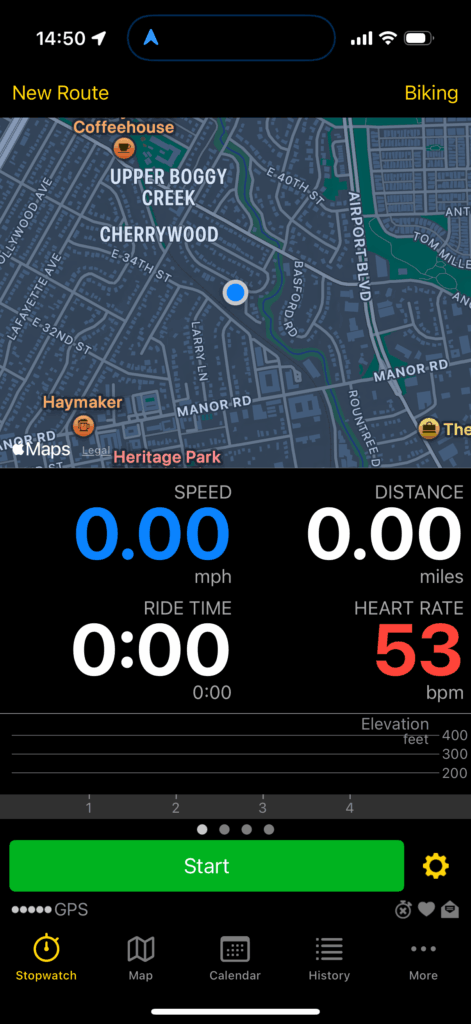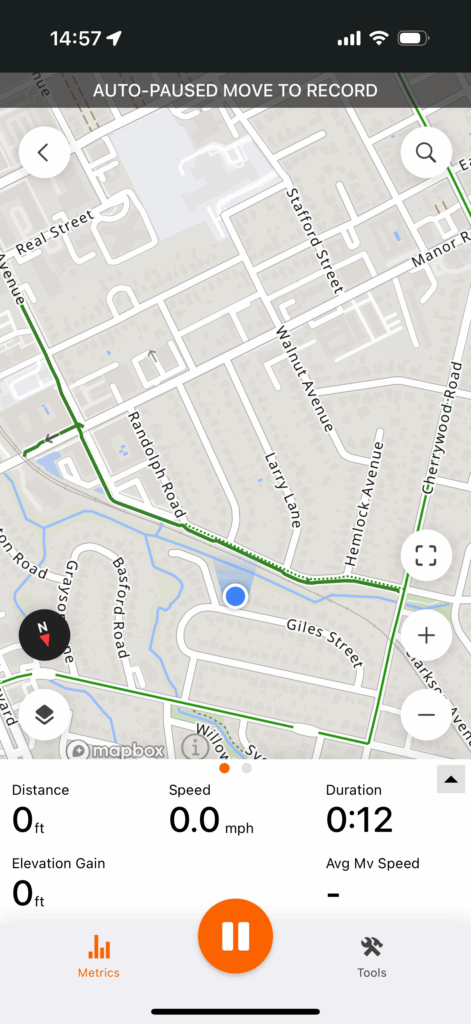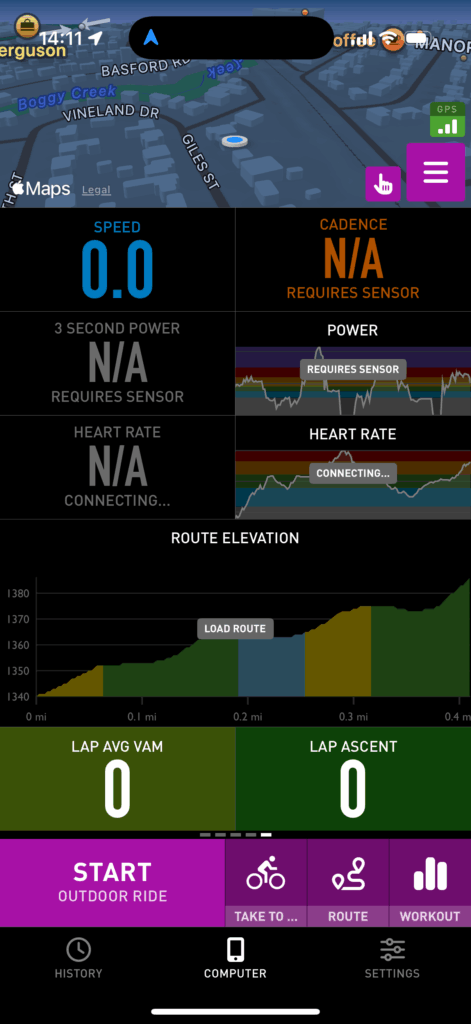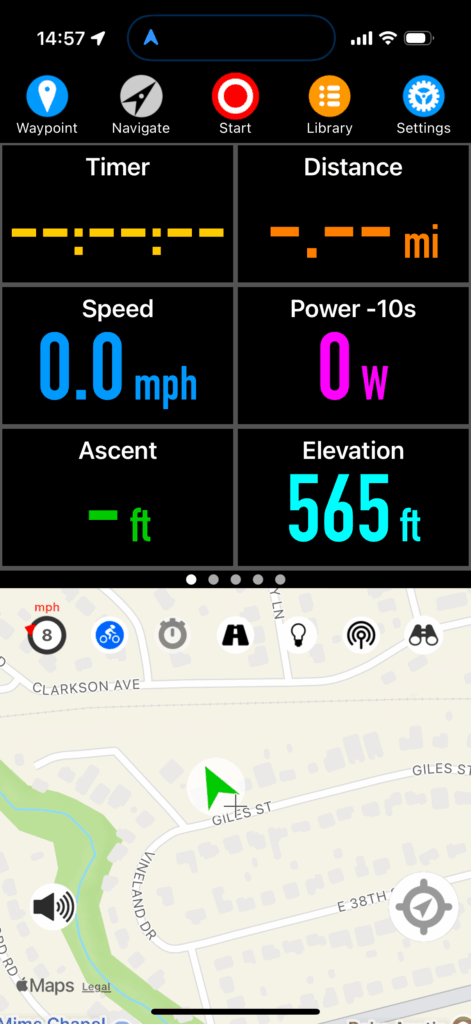Although most serious cyclists use dedicated head units, I’ve used iphone apps for about as long as I’ve had an iphone. I haven’t used all the apps that are out there, but I have used a few.
My own cycling interests lean towards long-distance rides and bikepacking. Nearly all my rides are solo. This informs what I do and don’t prioritize in an app. I currently do not have a power meter, although that will change at some point. I do use a heart-rate monitor.
The way I use all of these apps during a ride is mostly to rely on periodic spoken updates (via a bone-conduction headset) for my stats rather than looking at the screen. This lets me keep the screen dark, which makes a huge difference in battery life. Although I can keep my phone charged on the road as long as it’s not raining, I have ridden through rain that prevented me from charging my phone for 12 hours, and finished the ride with about 25% battery reserves. So these spoken updates are important to me. I set up each of these apps to recite my average speed and average heart rate for the entire ride, and for the past 15-minute split. I use this to judge my pacing. What I have found is that Ride with GPS doesn’t get these stats correct. Most (but not all) of the updates give the same values for the whole ride as for the last split, which is mathematically impossible unless I have perfect consistency (I don’t). Cadence and Cyclemeter seem to get these right. Navigr8 doesn’t give the option of reporting split average heart rate, though it will report split average speed.
The Ride with GPS app requires that you have an account with the service to use it, although they do offer free accounts as well as two tiers of paid memberships. Navigr8 requires you create an account on sign-in. Cyclemeter, Cadence, and Navigr8 all offer paid subscriptions to unlock additional features; I’ve paid for subscriptions to all of them and am evaluating them on that basis without paying attention to what is available at the free tier.
Cyclemeter, RwGPS, and Cadence all offer live tracking so that the folks back home can monitor your progress: the apps generate a link to a check-in page that you can send out. Cyclemeter can also e-mail notifications at regular intervals. Obviously these all depend on having internet connectivity during your ride. If you and the people who tracking you have Apple products, you can just use Find My, so this is mostly useful when sharing your progress with someone who does not.
Cadence and Navigr8 can keep the screen active but dimmed—I think of this as pseudo-locking. This is nice because it means you don’t need to unlock the screen in order to view the dashboard, just tap on it, but it also means that the screen is susceptible to unintended taps, and on Navigr8’s busy screen, that’s potentially a problem.
Battery life
The usual knock against using a smartphone as a bike computer is that the battery life isn’t good enough. I just described how I’ve adapted to using periodic spoken updates instead of keeping the screen on. But what if you want to keep the screen on, and don’t have a dynamo hub to keep the phone charged? What kind of battery life could you get?
I have an iPhone 16 Pro. This model is known to have great battery life in general. It’s about a year old and the battery health is rated at 100%. I set up Cyclemeter to keep the screen on for the duration of my ride, turned on energy savings, turned off wifi, and left the screen brightness at whatever level I normally keep it at (good enough for most conditions, but not direct sunlight). I had two Bluetooth devices connected: a heart-rate monitor, and a bone-conduction headset (playing music for most of the ride). After a ride lasting 2:50, the battery was at 82%. Assuming the burn rate is linear, this works out to about 6.35% per hour, or about 15.75 hours of use. Call it 12 hours to leave something in reserve in case of emergency. That is not as good as a top-tier bike computer, but it is good enough for a lot of situations.
Cyclemeter
Cyclemeter is one of the oldest apps on the App Store, and it shows. It is decidedly old-school in some ways: it relies on e-mail for outbound communication. It has a monolithic database rather than individual route/ride files. It organizes rides based on routes, which makes a certain amount of sense when performance over a known route is the only way you have of judging your fitness progress, but makes less sense in light of newer training metrics. Setting up the dashboard (Cyclemeter calls this the “stopwatch”) pages is really tedious.
It’s not all bad though. The dashboard display is the best of the lot, and is the only one that looks like a native app (it was developed for the iPhone but eventually was released for Android also). There’s good “fit and finish” on everything. Someone using the app for the first time should be able to launch it, tap the Start button, and go for a ride without any further instruction: the basic features are intuitive.
One quirk of this app is that although it can show a map view as a dashboard cell, you can’t pan or zoom that map. Instead, there’s a separate map tab for that. The dashboard can show a course elevation profile, but this is barely readable.

Ride with GPS
RwGPS is better known as a service for designing and sharing routes, but they do offer their own bike-computer app that is closely integrated with the service. RwGPS has staked out a different territory than Strava, and is not so much oriented toward performance cycling as toward touring, long-distance riding, and route-sharing. It does have segments and some of the same social features as Strava, but these don’t seem to be widely used. The app reflects this different focus. It lacks some pretty basic features, like a lap button. The dashboard screens give limited customization: you get 2 pages with 5 fields each, and you can customize what goes in each of those. And those fields are displayed in small type—the focus is on the map. But the app gives very fine-grained control over navigational alerts.
This is the only one of these apps that does not offer a dark mode. This is not just an aesthetic matter: all newish iphones have OLED displays, which means that only the lit-up pixels use electricity. A display that is mostly black will use less power. RwGPS partially makes up for this by being the only one of these to use live updates on the lock screen, a relatively new iOS feature, which lets you check your basic stats without unlocking the screen at all.
As far as I can tell, RwGPS is the only one of these apps that will display a cue sheet.
Like Cyclemeter, it’s intuitive. A first-time user shouldn’t be confused by it. A very high degree of “it just works.”

Cadence
Cadence is a newer app that’s trying to do it all: it acts as a regular bike computer, it lets you design routes, and lets you design structured workouts. This is ambitious for a one-man shop.
The way you edit the dashboard pages in Cadence is to go into the settings, where you can view a simplified schematic of your grid, and tap on cells to set their contents. Cadence gives you a lot of flexibility in how you populate the grid; it’s the only app that will show three cells in a row, and it maintains a completely separate set of dashboard layouts for landscape orientation. It’s the only one of these apps designed to work in landscape as near as I can tell. It can also show graphs in cells (of heart rate, for example), although this is just a novelty if you’re cramming the graph into a small cell.
One quirk of this app is the companion Apple Watch app: When you go for a ride, the Apple Watch will normally detect that you’re going for a ride, tap you on the wrist, and ask if you want to record the ride using Apple’s own Workout app. If you’re using one of these apps, you probably don’t want to do that. Cadence’s watch app will override the “do you want to record this?” notification, but not the wrist tap, which quickly gets annoying. I haven’t found a way to prevent that, short of turning off reminders from the Workout app entirely. I mentioned this to the developer and he shrugged it off. This is too bad because I like Cadence’s watch app better than any of the others on its own merits.
In theory, Cadence can import externally created routes, but in practice, this feature is not useful: it can only import GPX files, and it seems that a GPX file can either contain a path, or waypoints, but not both (or at least, RwGPS will only export one or the other but not both). It seems that the author is more focused on fleshing out the app’s internal route-design features than working with external services like RwGPS.
This is the only one of these apps that can run structured workouts. As of this writing, it cannot control a smart trainer, but the company’s website says that is planned for a future release. That would add a lot of value to this app.

Navigr8
Everything about Navigr8 is just nerdy and cartoony, starting with the name. The dashboard display is unpolished, with colorful icons, gridlines that are inconsistent and get chopped off by the screen’s rounded corners (not obvious in the screencaps), bad typography (is that…Arial?). The off-track and on-track trumpets sound like they’re from a circus. The map tiles try to cram way too many controls in, and in direct sunlight, they’re barely visible. The overall fit and finish feels poor. Although all these apps let you swipe left and right through dashboard pages (even RwGPS), this is the only one that doesn’t show swipe animations, which is frankly jarring.
Another jarring aspect of this app is that navigation and ride recording are separate operations. Normally one would load a route, tap the start button, ride the route, tap the stop button, and you’re done. With this, you load the route, tap the “navigate” button to navigate it, tap the “record” button to record the ride, then tap the “stop” button to finish the ride, and tape the “on track” (or “off track”) button to stop navigating.
The way you edit the dashboard on this app is by defining the grid in the settings, and then on the dashboard itself selecting each cell to decide what goes into it.
Navigr8 gamely attempts to estimate power based on what data you can give it if you don’t have a power meter, but I don’t believe the numbers it produces are remotely accurate.
It supposedly has something like Garmin’s ClimbPro that pops up an elevation profile when you’re on a big climb, but I did not see this. The elevation-profile cell shows a fixed-distance look-ahead, and can step through a few distance options.
One great feature is the ability to add a waypoint while riding, with a spoken note. The documentation goes into considerable detail on its waypoint features, and how they can be used to trigger certain events, which sounds interesting, but isn’t something I’ve tried.
I eventually got imported routes to work correctly, but it took some experimentation. There are a number of file formats that can be used in conjunction with bike-computer apps. GPX, FIT, TCX, KML. GPX is probably the best known, but least useful for sending turn-by-turn directions. It seems that a GPX file can contain either the route as lines on the map, or directions, but not both. FIT can contain both, and is a binary file format. TCX can contain both, and is an XML format. Navigr8 could import a FIT file, but treated it as the route only, without directions. A TCX file worked correctly, with both the route and directions and a custom POI that I added working correctly.
Getting a TCX file from RwGPS into it is a bit of a trick. The RwGPS app will not export TCX files or share them using the standard share sheet. In order to get the TCX file:
- Open the RwGPS website in your iphone’s browser.
- Navigate to the route you want, and under the MORE menu select “Export as File.”
- Choose the “TCX Course” file type and download it.
- Open the Files app. The Files app separates your files between “on my phone” and “iCloud Drive.” Make sure you’re in iCloud Drive.
- Open the Downloads folder.
- The downloaded TCX file should be at the top of the list. Press and hold on it to bring up a menu of options, and tap Share.
- From the resulting list of share targets, select Navigr8. You might need to scroll to the side of the sideways list of target apps and tap “More” to find it.
This is kind of a pain. RwGPS could make it easier if they wanted to.
Navigr8 has a lot of promise, but it needs a lot of work.

Feature comparison
| Feature | Cyclemeter | RwGPS | Cadence | Navigr8 |
|---|---|---|---|---|
| Dashboard | ||||
| Custom dashboard pages | 🟢 | 🔴 | 🟢 | 🟢 |
| Music control | 🟢 Locally stored music only | 🔴 | 🔴 | 🔴 |
| Weather data | 🟢 | 🔴 | 🟢 | 🟢 |
| Elevation profile | 🟢 | 🟢 | 🟢 | 🟢 |
| Offline map tiles | 🔴 | 🟢 | 🟢 | 🟢 Possible but awkward |
| Map providers | Apple, Google | Numerous | Apple, Google, Mapbox | Apple, Google |
| Lap button | 🟢 | 🔴 | 🟢 | 🟢 |
| Custom screen lock | 🟢 | 🟢 | 🟢 | 🟢 |
| Screen dim | 🔴 | 🔴 | 🟢 | 🟢 |
| Integrations | ||||
| Ride with GPS | 🔴 | 🟢 | 🔴 | 🔴 |
| Training Peaks | 🔴 | 🔴 | 🔴 | 🔴 |
| Intervals.icu | 🔴 | 🔴 | 🟢 | 🟢 |
| Strava | 🟢 | 🟢 | 🟢 | 🟢 |
| Apple Health | 🟢 | 🟢 | 🟢 | 🟢 |
| Navigation | ||||
| Turn-by-turn directions | 🔴 | 🟢 Works with RwGPS maps only | 🟢 Internally designed routes only | 🟢 With some trouble |
| Live tracking | 🟢 | 🟢 | 🟢 | 🔴 |
| Notifications | ||||
| Live activities on lock screen | 🔴 | 🟢 | 🔴 | 🔴 |
| Periodic spoken notifications | 🟢 | 🟢 | 🟢 | 🟢 |
| Other | ||||
| Apple Watch companion app | 🟢 | 🟢 | 🟢 | 🟢 |
| Alternative display device | 🟢 House-brand dashboard panel | 🔴 | 🟢 ActiveLook AR glasses | 🟢 ActiveLook AR glasses |
| Training Plan manager | 🟢 | 🔴 | 🟢 | 🔴 |
| Ghost competitor | 🟢 | 🔴 | 🔴 | 🟢 |
Other thoughts
Most bike-computer apps offer a lot of flexibility in dashboard layout, but not a lot of discipline. It would make more sense to have rows of related items. Like all heart-rate data on one row, all weather day on one row, etc. Grouping like data together should make it possible to show more data more clearly in less space.
They also don’t show a lot of creativity in how data is displayed—for the most part, they’re taking the same “spreadsheet” approach that head units do, when so much more is possible. I’d love to see a histogram of my heart rate with the current zone highlighted, for example. But to take the spreadsheet concept in a different direction, a bike-computer app could give users the option to fill each cell with the result of a formula, given certain data primitives as terms in the formula. To go a step further, I imagine an app where the dashboard is a WebKit view that takes advantage of HTML, CSS, Javascript, and a library like D3 for data visualization. Custom fields could be shared as small chunks of code.
Years ago, when Saab was a company that made cars, they had a feature they called “night panel,” which would black out all the instruments except for the speedometer and anything that required your attention. I imagine something like this for a bike-computer app, where the screen “pseudo-locks” the way Cadence does, and you can specify certain fields that will stay lit up in this state.
If you use Training Peaks or other external services that aren’t well-supported, you probably want to download either HealthFit or RunGap. These both act as “switchyards” for your workout files, and can sync them to and from external services. I’ve tried both and am currently using HealthFit.